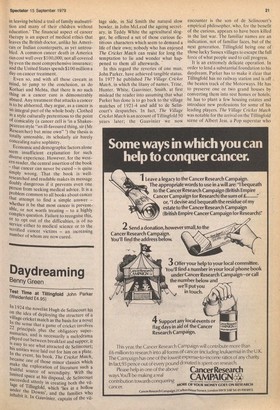Daydreaming
Benny Green
Test Time at Tillingfold John Parker (Weidenfeld £4.95) In 1924 the novelist Hugh de Selincourt hit on the idea of deploying the structure of a Village cricket match as the basis for a novel In the sense that a game of cricket involves 22 principals plus the obligatory supernumaries, and is necessarily a melodrama Played out between breakfast and supper, it Is easy to see what attracted de Selincourt; his unities were laid out for him on a plate. In the event, his book, The Cricket Match, became one of those minor classics which make the exploration of literature such a fruitful source of serendipity. With the limited space at his disposal, de Selincourt succeeded utterly in creating both the village of Tillingfold, which 'lies in a hollow nder the Downs', and the families who inhabit it. In Gauvinier, captain of the vil lage side, in Sid Smith the natural slow bowler, in John McLeod the ageing secretary, in Teddy White the agricultural slogger, he offered a set of those curious fictitious characters which seem to demand a life of their own; nobody who has enjoyed The Cricket Match can resist for long the temptation to lie and wonder what happened to them all afterwards. In this regard the reveries of one man, John Parker, have achieved tangible status. In 1977 he published The Village Cricket Match, in which the litany of names, Trine, Hunter, White, Gauvinier, Smith, at first mislead the reader into assuming that what Parker has done is to go back to the village matches of 1921-4 and add to de Selincourt's despatches. In fact, The Village Cricket Match is an account of Tillingfold 50 years later; the Gauvinier we now encounter is the son of de Selincourt's empirical philosopher, who, for the benefit of the curious, appears to have been killed in the last war. The familiar names are an indication, not of familiar faces, but of the next generation. Tillingfold being one of those lucky Sussex villages to escape the full force of what people used to call progress.
It is an extremely delicate operation. In order to lend a substantial foundation to his daydream. Parker has to make it clear that Tillingfold has no railway station and is off , the beaten track of the Motorways. He has to preserve one or two grand houses by converting them into rest homes or hotels; he has to plant a few housing estates and introduce new professions for some of his leading players. The Village Cricket Match was notable for the arrival on the Tillingfold scene of Albert Jess, a Pop superstar who has decided to return to the land, and James Mitterman. one of those City fixers whose fortunes ebb and flow with the price of property. Vocabulary and morality must also be seen to have altered, and even the ' grumbling of the players. centred on the debatable virtues of the limited-over revolution, is not quite the grumbling on which de Selincourt so decorously eavesdropped so long ago.
But Parker's most awesome challenge has been to dare to recreate de Selincourt's rustic paradise without offending the sensibilities of old readers. In The Village Cricket Match he displayed considerable skill without ever coming remotely close to the intensity of de Selincourt's pathos. In his second attempt, the reference in his title to a test concerns a crisis in the club's affairs when developers cast their eyes on the cricket ground. There is the usual sequence of events, planning applications, petitions, protests. backstage manipulation, and. in the end, a victory predictable from the very first page. At one of the protest meetings, Gauvinier makes a speech which defines exactly the nature of the attempt by Parker to work the rich seam of de Selincourt's cricketing paradise: good, in spite of everything. It's not so much a question of burying our heads in the sand, but here tucked in behind the Downs we've been protected from most of the rough winds of the 20th century. I want it to stay that way. We've missed the railway, and the motorway, and the airport, and the new town. I reckon we can go on doing without them for a few hundred years more, If Parker has by now drifted so far from the spirit of de Selincourt, it is not just because he lapses into the conventional tritenesses of sexual innuendo, although if de Selincourt never found it necessary to describe Sid Smith's penchant for hay lofts, it is hard to see why Parker should. The real flaw in Test Time at Tillingfold is that it lacks the disciplines imposed by the unities Qf the one-day game, a problem which I suspect also plagued de Selincourt, who never quite remembered the magic incantations of The Cricket Match. But in view of Parker's campaign, it might be an opportune moment to republish de Selincourt's volume of Tillingfold short stories, The Game of the Season, and perhaps the more juvenile The Saturday Match. In the meantime, Parker's published reveries on behalf of Tillingfold devotees certainly pass muster.



































 Previous page
Previous page